If you’re searching for salad meal prep ideas that actually stay fresh, taste great, and make healthy eating easier, you’re in the right place. This guide will walk you through everything you need to know from the best containers to use, to recipes that hold up over several days, to storage methods that prevent sogginess. Whether you’re prepping for weight loss, a busy workweek, or just trying to eat more veggies without daily chopping, you’ll find practical answers here.
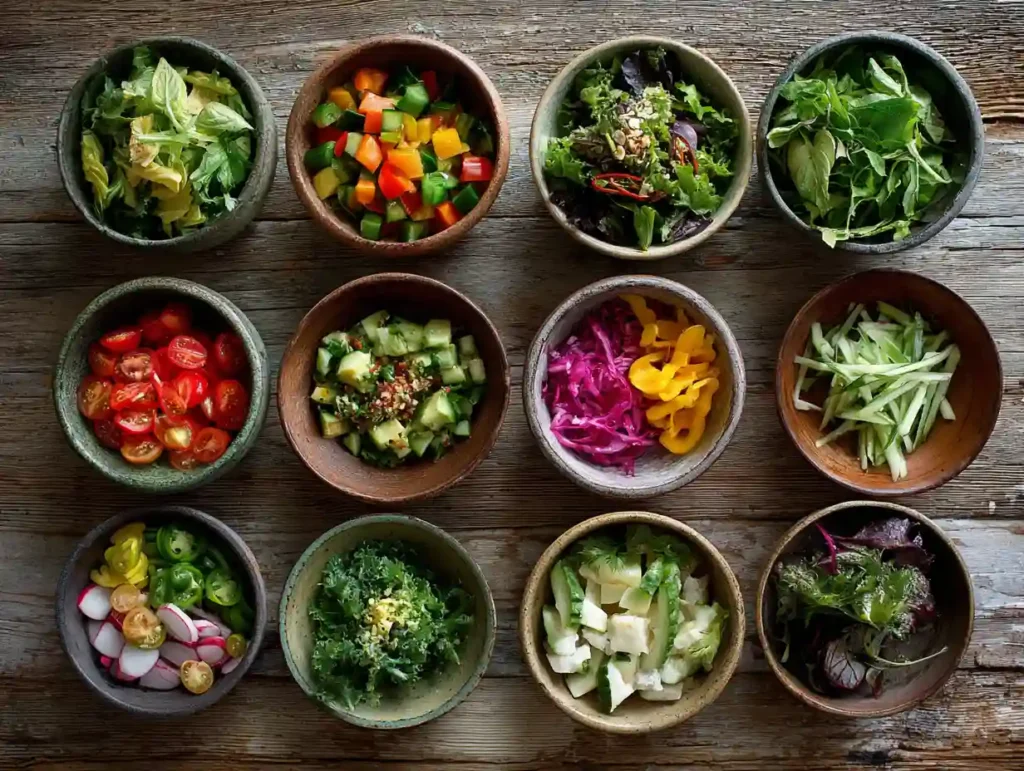
When I first started meal prepping salads, I made every mistake you can imagine. I threw together greens in a rush, added dressing too early, and by day two, my fridge was full of wilted disappointment. But over time with the right tools like airtight salad meal prep containers and smart ingredient choices like kale, quinoa, and chickpeas I learned how to prep flavorful, crisp salads that lasted all week. This routine didn’t just save me time; it made healthy eating feel doable and satisfying.
Jump
Benefits of Salad Meal Prep
Meal prepping salads isn’t just about saving time it’s a small habit that delivers big returns for your health, wallet, and daily routine. When done right, salad meal prep helps you make intentional food choices, reduce waste, and avoid last-minute takeout. For anyone aiming to eat more vegetables, maintain weight loss, or build a balanced plate, having ready-to-eat salads on hand turns a good intention into an effortless reality.
From a nutritional standpoint, regularly eating salads made with leafy greens like spinach, arugula, or romaine boosts your intake of fiber, folate, and antioxidants. According to the Harvard T.H. Chan School of Public Health, plant-forward diets rich in vegetables are associated with lower risks of heart disease and type 2 diabetes. Meal prepping makes it easier to follow this path consistently. Plus, when you prep in advance using airtight salad meal prep containers, you maintain freshness and avoid the common excuse of “nothing healthy is ready.”
There’s also a mental benefit. Knowing your lunch or dinner is already made cuts down on decision fatigue and helps keep your kitchen (and mind) clutter-free. Whether you’re building bean salad meal prep bowls or packing salad jars meal prep style, having a fridge stocked with vibrant, ready-to-eat options can be a quiet form of self-care in a chaotic week.
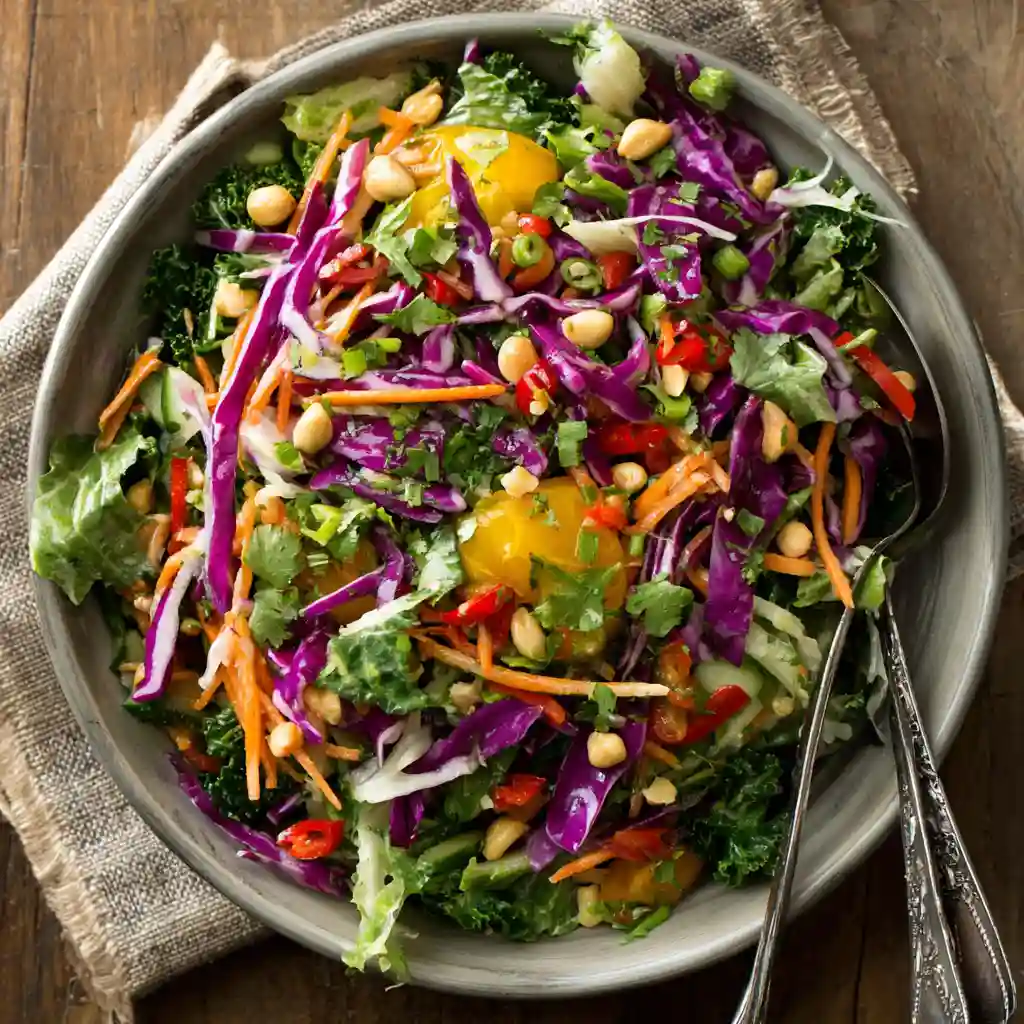
Thai Chopped salad meal prep
Ingredients
Method
- In a large bowl, mix together all salad ingredients.
- To make the dressing, whisk together all dressing ingredients in a medium sized bowl.
- Pour the dressing over the salad and toss to coat.
- Once the salad is thoroughly coated in the dressing, sprinkle with optional toppers such as cilantro, roasted peanuts, green onions and jalapeno!
Notes
Best Salad Meal Prep Containers
Choosing the right salad meal prep containers can make or break your prep routine. A good container doesn’t just hold ingredients it protects texture, locks in freshness, and makes your salads easy to grab and go. If you’ve ever opened a container to find soggy greens or a leaky mess, you know how essential the right storage is to success.
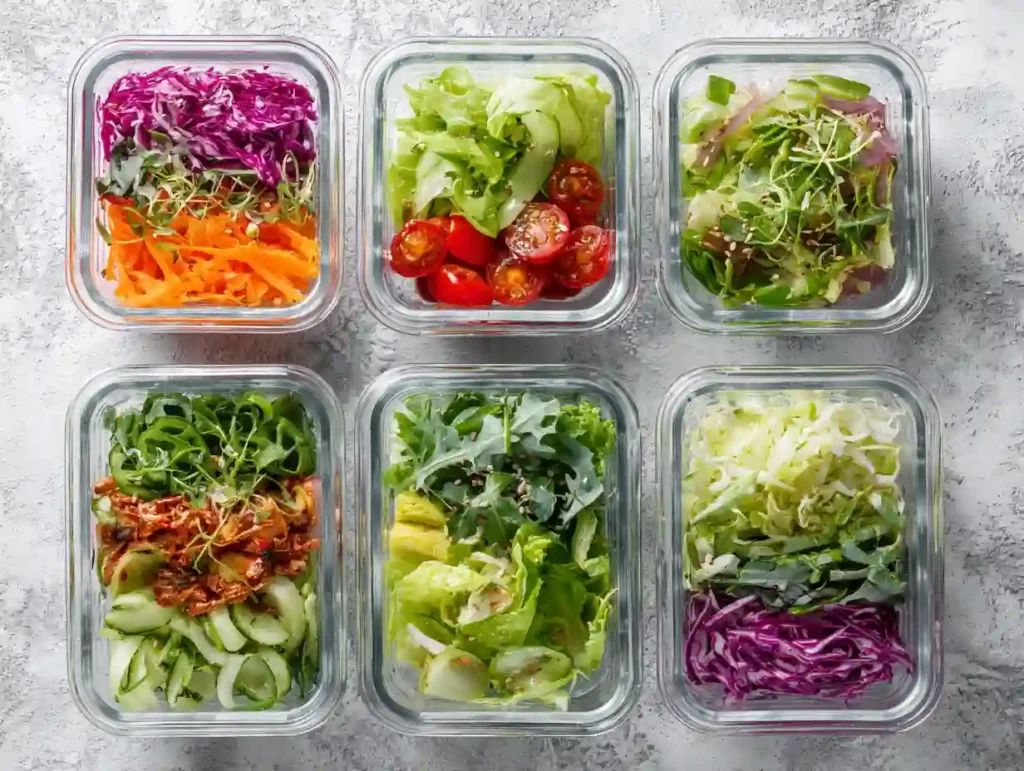
For leafy greens and layered ingredients, glass containers with locking lids are a top choice. Brands like Pyrex and Ello Duraglass offer BPA-free, dishwasher-safe options that seal tightly and don’t absorb odors or stains. Glass also helps keep vegetables crisp longer compared to plastic. If portability is your priority, compartment-style containers or bento-style salad boxes work great. They let you keep wet and dry ingredients separate especially important for toppings like cherry tomatoes, roasted chickpeas, or grilled chicken. This avoids early mixing, which is one of the main reasons salads lose freshness.
Another popular solution is salad jars meal prep style. Mason jars (like the wide-mouth Ball or Kerr brands) allow for vertical layering: dressing on the bottom, hardy ingredients in the middle (like quinoa, cucumbers, beans), and delicate greens on top. When you’re ready to eat, just shake and serve.
For best results, look for containers that are leak-proof, stackable, and sized right for your meals. Investing in the right meal prep salad containers is one of the simplest ways to extend shelf life, reduce waste, and keep your weekly prep smooth and stress-free.
How Do You Keep Meal Prep Salads Fresh and Not Soggy?
To keep meal prep salads fresh and not soggy, store wet and dry ingredients separately and avoid adding dressing until just before eating. Use airtight salad meal prep containers to reduce moisture exposure and layer your salad properly. Start with the dressing on the bottom (if using a jar), then add hearty vegetables like cucumbers, bell peppers, or beans, followed by proteins such as grilled chicken or chickpeas, and place delicate greens like spinach or arugula on top. This layering method prevents wilting by keeping greens away from moisture.
Use moisture-resistant greens like kale, romaine, or cabbage, which hold up better over several days. Line the bottom of your container with a dry paper towel to absorb excess humidity and extend freshness. According to USDA food safety guidelines, storing prepped salads at or below 40°F (4°C) in the refrigerator helps preserve texture and nutrient quality.
For best results, prep salads no more than 4–5 days in advance and check for ingredients that spoil faster, like avocados or boiled eggs store these separately and add them the day you eat. By combining smart storage with proper ingredient choices, you can keep your salads crisp, flavorful, and safe all week long.
What’s the Best Way to Stock Salads for a Week of Meal Prep?
The best way to stock salads for a week of meal prep is to plan five to seven balanced recipes in advance, prep ingredients in bulk, and store them in airtight, portioned salad meal prep containers. Start by choosing durable greens like kale, romaine, or cabbage that hold their texture for several days. Wash, dry, and store these greens separately or layer them on top in salad jars meal prep style to prevent contact with moisture-heavy items.
Organize ingredients by type proteins (such as grilled chicken or tofu), cooked grains (like quinoa or brown rice), and chopped vegetables (peppers, carrots, cucumbers) and refrigerate them in clear containers for easy assembly. For maximum freshness, avoid pre-mixing dressing; instead, store it in small separate containers or add it right before serving.
Use a simple rotation system: label each container by day (Monday through Friday), or stack them by date. According to the Academy of Nutrition and Dietetics, prepping ahead not only saves time but also supports healthier eating habits by reducing impulsive food choices. With a smart strategy and quality containers, you can enjoy fresh, crisp salads every day with minimal daily effort.
Meal Prepping Salads for the Week
Successfully prepping all your salads for the week starts with choosing the right recipes and building a clear, realistic plan. The first step is to identify which types of meal prep salads you and your family enjoy whether it’s high-protein bowls, vegetarian options, taco salad meal prep, or hearty pasta salad meal prep. Once you’ve decided, write out a simple plan in a notebook or digital planner. This helps you visualize your week and avoid last-minute decisions.
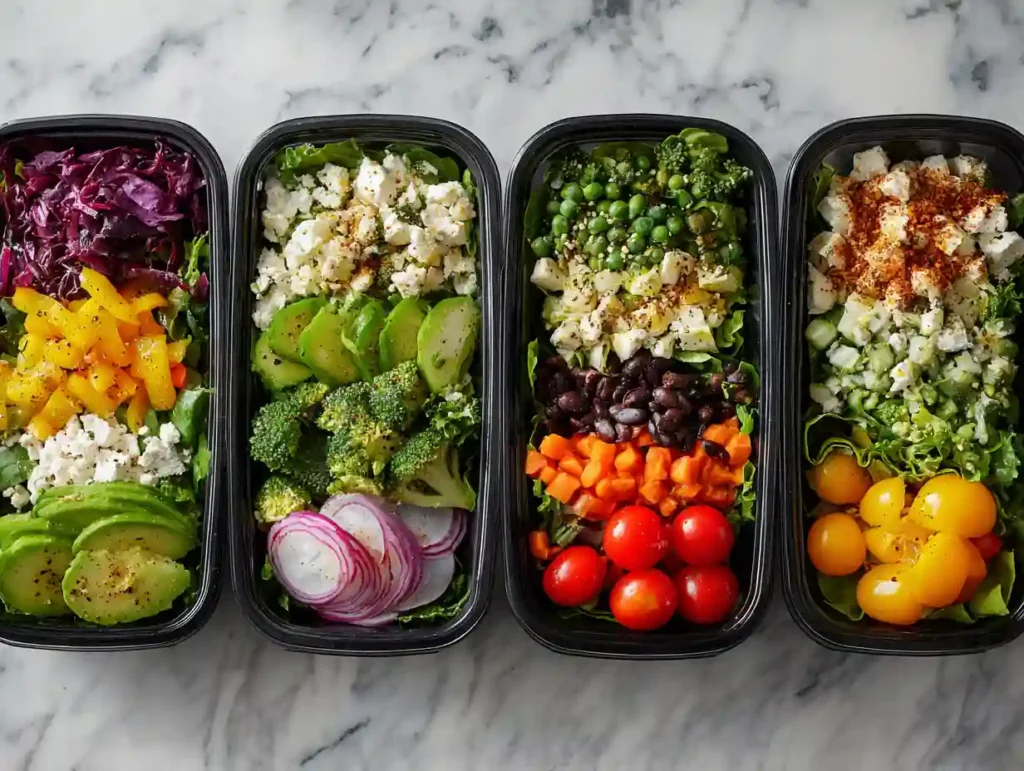
Next, create a detailed shopping list based on your chosen recipes. Organize ingredients by category greens, proteins, grains, dressings, and toppings to streamline your grocery trip. If you’re feeding a family, be sure to scale the ingredient quantities to match the number of servings needed across the week.
After shopping, dedicate one afternoon to prep everything at once. Wash and chop all vegetables, cook any proteins like chicken breast, hard-boiled eggs, or quinoa, and portion ingredients based on your plan. Use clearly labeled salad meal prep containers or meal prep salad jars to separate salads by day or meal type.
To keep your week flexible, consider mixing and matching your prepped ingredients for example, turning one batch of roasted chickpeas into two completely different salads. Drawing inspiration from the easy salad meal prep recipes in this article will help keep your meals varied, satisfying, and aligned with your nutrition goals.
By approaching your prep day like a system plan, list, shop, prep, and store you not only reduce stress during the week but also turn healthy eating into a consistent, low-effort habit.
Easy Salad Meal Prep Recipes
When it comes to salad meal prep, simplicity is key but that doesn’t mean sacrificing variety or flavor. The following recipes are designed to be quick to assemble, packed with nutritious ingredients, and stable enough to stay fresh for several days in the fridge.

These ideas also help you incorporate high-fiber vegetables, plant-based proteins, and whole grains, all while supporting diverse dietary goals like weight loss, high protein, or vegetarian eating.
1. Mediterranean Chickpea Salad
Loaded with protein-rich chickpeas, cherry tomatoes, cucumbers, red onion, and parsley, this salad holds up beautifully through the week. Toss with olive oil, lemon juice, and a sprinkle of feta just before serving.
2. Chicken Taco Salad (Meal Prep Style)
Start with a base of shredded romaine, add black beans, grilled chicken, corn, diced bell peppers, and a dash of chili-lime seasoning. Store your creamy cilantro-lime dressing separately to prevent sogginess.
3. Quinoa & Roasted Veggie Salad
Roasted sweet potatoes, zucchini, and bell peppers meet cooked quinoa and arugula in this nutrient-dense bowl. It’s ideal for vegetarian meal prep salad recipes, and works well warm or cold.
4. Pasta Salad Meal Prep with Pesto
Use whole grain pasta, cherry tomatoes, olives, fresh mozzarella, and a spoonful of basil pesto for a satisfying option that lasts 3–4 days. This meal prep pasta salad is ideal when you want something more filling without cooking every night.
5. Thai Chopped Salad (Meal Prep Friendly)
Crunchy cabbage, shredded carrots, edamame, and green onions come together with a sesame ginger dressing (stored separately). Top with cashews for texture. This one’s bold in flavor and perfect for salad jar meal prep.
Each of these meal prep salad ideas can be scaled for multiple servings, portioned into individual containers, and stored for the week. Whether you’re preparing for busy work lunches or healthy family dinners, these recipes provide structure without limiting your creativity.
Meal Prep Salads for Weight Loss
If you’re trying to lose weight in a sustainable way, meal prep salads can help you stay consistent without feeling deprived. By combining high-volume, low-calorie ingredients with protein and fiber, these salads promote satiety and stable energy throughout the day both key factors in effective weight management.
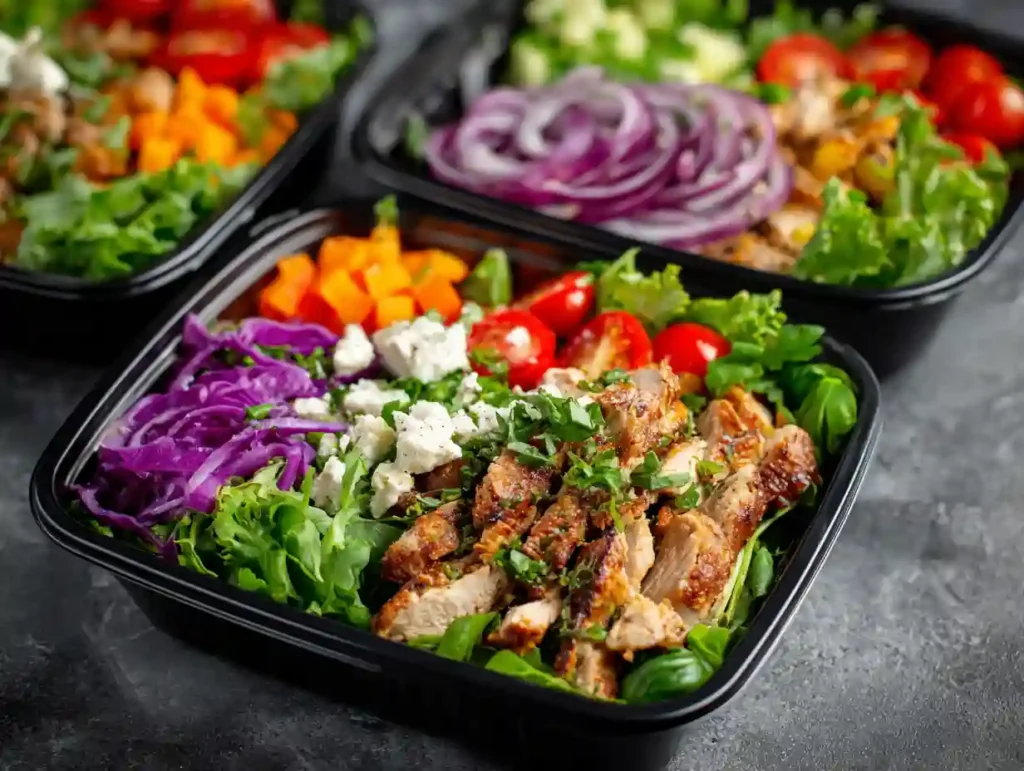
Start with dark leafy greens like kale, arugula, or spinach, which are low in calories but high in micronutrients and fiber. Add lean proteins such as grilled chicken, tofu, hard-boiled eggs, or chickpeas. According to a 2010 review published in Nutrients, diets higher in protein improve appetite control, increase thermogenesis, and preserve lean muscle mass during weight loss (Leidy HJ et al. 2010).
To increase fiber and texture, incorporate vegetables like shredded carrots, cucumbers, and bell peppers, along with legumes like black beans or lentils common staples in bean salad meal prep. Top it off with healthy fats in small portions, such as a tablespoon of olive oil, avocado slices, or sunflower seeds. Research from Harvard’s School of Public Health supports the inclusion of unsaturated fats for improved satiety and metabolic health.
For effective portioning, use salad meal prep containers with compartments or try salad jars meal prep style, layering ingredients to prevent sogginess. Keep dressings especially oil-based ones in separate containers and measure portions to avoid hidden calories.
A balanced meal prep salad for weight loss might include:
- 2 cups leafy greens
- 4 oz grilled chicken or ½ cup chickpeas
- ½ cup chopped vegetables
- 1 tablespoon vinaigrette or olive oil
- Optional: ¼ avocado or a boiled egg
This formula supports fullness, flavor, and convenience three things that make healthy eating easier to stick with long term.
Meal Prep Salads for Vegetarians
Vegetarian meal prep salads are a smart, flexible way to stay nourished throughout the week without relying on animal products. When designed well, these salads can be just as satisfying and protein-rich as their meat-based counterparts, while offering a wider range of vitamins, minerals, and plant diversity.
To build a balanced vegetarian salad, start with a base of fiber-rich greens like kale, baby spinach, or romaine lettuce. Add complex carbohydrates from whole grains such as quinoa, farro, or bulgur. For protein, legumes and soy-based foods are excellent choices chickpeas, lentils, edamame, tofu, and tempeh all work well. Finish with a small portion of healthy fats such as avocado, nuts, seeds, or tahini-based dressings.
Here are five vegetarian meal prep salad ideas you can prep and rotate throughout the week:
1. Mediterranean Chickpea Salad
- Chickpeas, cherry tomatoes, cucumbers, red onion, parsley, feta (optional), and a lemon-olive oil dressing.
- Use in salad jars meal prep format or portioned containers.
2. Roasted Veggie & Quinoa Salad
- Roasted sweet potatoes, zucchini, red bell peppers, red onion, cooked quinoa, baby spinach, and tahini-maple dressing.
- Stays fresh for up to 4 days in airtight containers.
3. Edamame Power Bowl
- Edamame, shredded carrots, purple cabbage, green onions, cooked brown rice, sesame seeds, and soy-ginger dressing.
- High in plant-based protein and ideal for lunch.
4. Lentil & Beet Salad
- Cooked lentils, roasted beets, arugula, orange segments, and walnuts with a citrus vinaigrette.
- Excellent source of iron and antioxidants.
5. Mexican-Inspired Black Bean Salad
- Black beans, corn, diced red peppers, cherry tomatoes, avocado (added fresh), cilantro, and lime dressing.
- Works well as a taco salad meal prep alternative without meat.
All of these salads can be prepped in batches using salad meal prep containers or meal prep salad jars, stored for 3–5 days in the fridge, and adapted for your personal taste. They’re proof that vegetarian eating can be anything but boring colorful, nutrient-dense, and convenient for even the busiest weeks.
Salad Meal Prep Jars
Salad meal prep jars have become one of the most efficient and visually satisfying ways to prep salads ahead of time. Popularized through platforms like Pinterest and Instagram, these vertical, layered salads aren’t just trendy they actually solve a common problem in meal prep: sogginess.

When assembled properly, salad jars keep ingredients fresh and crisp for up to five days, making them ideal for work lunches, quick dinners, or grab-and-go meals.
Here’s a basic formula to build a successful meal prep salad jar:
- Bottom Layer: 2–3 tablespoons of dressing (vinaigrette, tahini, or yogurt-based)
- Hearty Veggies/Beans: Cherry tomatoes, cucumbers, red onions, corn, black beans
- Grains/Protein: Quinoa, chickpeas, tofu, lentils, edamame
- Soft Add-ins: Roasted veggies, feta, nuts
- Top Layer: Leafy greens (spinach, kale, romaine)
Choose wide-mouth mason jars (16 to 32 oz) for easy assembly and serving. Always refrigerate your jars upright, and if you’re including ingredients like avocado or boiled eggs, store them separately and add them just before eating to maintain freshness.
Using salad jars not only helps with portion control but also adds variety and structure to your week. Whether you’re making a bean salad meal prep, a Thai chopped salad, or a pasta salad meal prep version, this method keeps things organized, portable, and delicious.
Best Leafy Greens for Meal Prep Salads
Choosing the right leafy greens is one of the most important decisions when planning your salad meal prep. Not all greens hold up the same way in the fridge some wilt or turn soggy within a day, while others stay crisp and vibrant for the entire week. Understanding which varieties perform best in storage helps you build salads that are both flavorful and long-lasting.
Sturdy leafy greens like kale, romaine, green cabbage, and Swiss chard are the top choices for meal prep salads. These greens have firm cell structures and lower moisture content, which means they resist wilting and maintain their texture even when stored with other ingredients. Kale, in particular, benefits from being pre-massaged with a bit of olive oil or lemon juice, which softens it slightly and makes it more palatable without compromising shelf life.
Moderately stable greens such as baby spinach, arugula, and spring mix can also be used in salad meal prep, but with extra care. They should be stored separately or placed on top of layered salads in salad jars meal prep style to avoid direct contact with wet ingredients. Adding these types of greens just before eating helps maintain their delicate texture and prevents sogginess.
Here’s a comparison of leafy greens and their suitability for meal prep:
| Leafy Green | Storage Life (Days) | Ideal Use |
|---|---|---|
| Kale | 4–6 | Massaged, base for hearty salads |
| Romaine | 4–5 | Crisp base for taco or chicken salads |
| Green Cabbage | 5–7 | Shredded in chopped or Asian-style salads |
| Swiss Chard | 3–4 | Sautéed or raw in mixed salads |
| Baby Spinach | 2–4 | Added fresh on serving day |
| Arugula | 2–3 | For flavor boost; keep separate |
| Spring Mix | 2–3 | Use early in the week; store separately |
To extend the freshness of any leafy green, make sure it’s thoroughly dried after washing. Excess moisture is the most common cause of early spoilage.
Common salad meal prep Mistakes to Avoid
Even with the best intentions, many people struggle to keep their salad meal prep fresh, flavorful, and worth eating by midweek. Small missteps in planning, storage, or ingredient choice can lead to soggy textures, bland taste, or wasted food. To make your efforts pay off, here are the most common mistakes to avoid and what to do instead.
1. Adding Dressing Too Early
One of the most frequent mistakes is adding dressing when assembling the salad. Unless you’re using a salad jar meal prep method with the dressing on the bottom, liquids will wilt your greens quickly. Store dressings in small, separate containers and add them right before eating.
2. Choosing Delicate Greens for Long Storage
Spring mix and baby spinach might look appealing, but they break down fast. If you’re prepping for more than two days in advance, stick to sturdy greens like romaine, kale, or cabbage. These greens hold up better in the fridge and don’t get slimy as quickly.
3. Not Drying Greens Properly
Moisture is the enemy of freshness. If your lettuce or spinach goes into the container even slightly wet, it will wilt rapidly. Always spin or pat greens dry before storage, and line containers with a paper towel to absorb excess humidity.
4. Overloading on Wet Ingredients
Ingredients like tomatoes, cucumbers, or fruits release water over time. If you include them, layer them away from the greens or store them separately. This is especially important in meal prep salad jars or layered containers.
5. Ignoring Portion Control
Without a plan, it’s easy to under- or over-prep. Too few ingredients and you’ll run out midweek; too much, and you’ll waste food. Consider how many meals you need, how many people you’re feeding, and use meal prep salad containers with proper portion sizes.
6. Using the Same Salad All Week
Monotony is a common reason people abandon meal prep salads. Even small changes like swapping the dressing, rotating toppings, or alternating proteins can keep meals exciting without extra prep time.
7. Storing Everything in One Container
Throwing all ingredients into one bowl or box might seem convenient, but it speeds up spoilage. Separate wet and dry elements, or use containers with compartments. This extends shelf life and preserves taste and texture.
By avoiding these mistakes, your salad meal prep ideas will become something you actually look forward to eating not just a healthy checkbox. With the right habits, you’ll waste less food, save more time, and enjoy fresh, satisfying meals every day.
How Long Do Meal Prep Salads Last in the Fridge?
Most meal prep salads last 3 to 5 days in the fridge, depending on the ingredients and how they are stored. Salads made with hearty greens like kale, cabbage, or romaine tend to stay fresh longer, while those using delicate leaves like spinach or arugula may wilt faster. The presence of dressing also affects shelf life pre-dressed salads typically last only 1 to 2 days, whereas dry, layered salads can maintain quality much longer.
Here’s a quick reference table to help:
| Salad Type | Refrigerated Shelf Life | Notes |
|---|---|---|
| Leafy greens (dry, undressed) | 4–5 days | Best with romaine, kale, or cabbage |
| Leafy greens (with dressing) | 1–2 days | Add dressing just before serving to extend life |
| Grain-based (quinoa, farro) | 5–6 days | Very stable; keep dressing separate |
| Bean salads | 4–6 days | High in fiber and protein, rarely affected by storage |
| Pasta salad meal prep | 3–5 days | Use sturdy pasta; avoid soft vegetables |
| Chicken salad meal prep | 3–4 days | Store in airtight container, keep chilled under 40°F |
According to USDA food safety guidelines, perishable prepared foods should be consumed within 3 to 5 days when stored at or below 40°F (4°C). For best results, always use salad meal prep containers that are airtight, and avoid opening and resealing multiple times. If you’re unsure about freshness, check for off smells, slimy texture, or visible discoloration signs it’s time to toss it.
This guide helps answer the common question, Can you meal prep salad for the week? yes, you can, as long as you match the ingredients and storage method to the number of days you plan to eat it.
FAQ
How to prep salad for 1 week?
Choose sturdy ingredients like kale, cabbage, beans, and grains. Wash and dry everything well, layer in jars or containers, and add dressing only when ready to eat.
How to meal prep salad for 3 days?
Use leafy greens like spinach, add proteins like chicken or tofu, and store in airtight containers. Keep dressing and soft toppings separate to maintain freshness.
How long will prepared salad last in the fridge?
Prepared salads typically last 3–5 days in the fridge. Undressed salads with hearty ingredients last longer than those with dressing or soft vegetables.
Conclusion
Meal prepping salads doesn’t have to be boring, soggy, or repetitive. With the right planning, smart storage, and flavorful combinations, salad meal prep becomes a practical and rewarding way to eat healthier, save time, and stay consistent throughout the week. Whether you’re looking to lose weight, eat more plant-based meals, or simply avoid daily cooking stress, having fresh, ready-to-go salads in your fridge is a game changer.
Personally, I love this approach because it takes the pressure off my week. There’s something satisfying about opening the fridge and seeing a row of colorful, well-balanced salads waiting for me. It reminds me that I’ve taken care of myself ahead of time and that makes healthy eating feel less like a chore and more like an act of self-respect.
